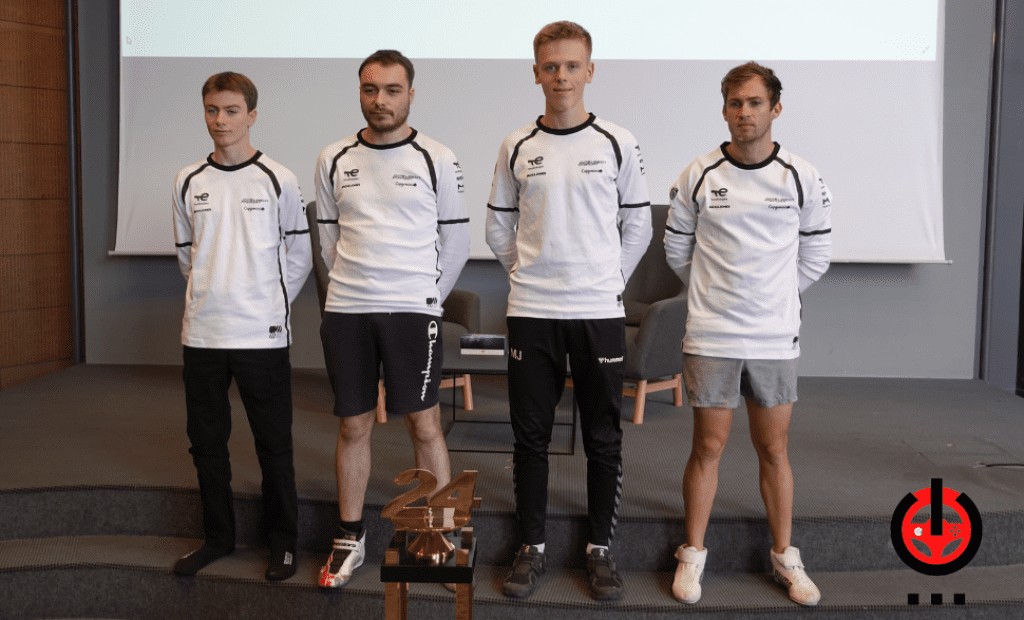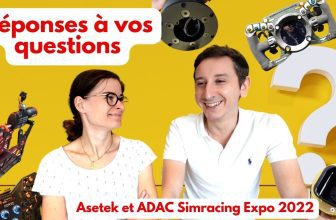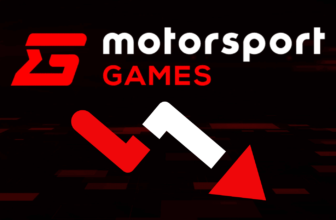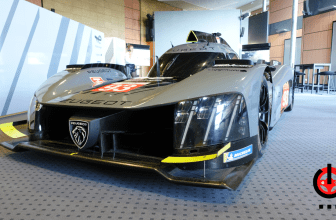Today I’d like to introduce you to Gustavo Menezes. 2016 WEC champion in the LMP2 category, winner of the 2016 Le Mans 24h in LMP2 and entered in LMH for the 2023 season as part of the Peugeot Total Energies crew. He also took part in the virtual 24h du Mans with the Peugeot Sport team. It was on this occasion that I was able to ask him a few questions. Here, he explains the differences between simracing and reality!
The background to the meeting with Gustavo Menezes

The meeting took place on January 13, 2023 at Peugeot Sport HQ in Satory. The whole team was there to take part in the virtual 24 hours of Le Mans run on the rFactor 2 simulation.
Race rules require teams to field 2 professional drivers and 2 simracers.
The Peugeot Sport team included :
- Gustavo Menezes : WEC Peugeot Sport driver. 2016 WEC LMP2 world champion, winner of the 24 hours of Le Mans in the LMP2 category in 2016.
- Malthe Jakobsen : 2022 WEC LMP3 World Champion, took part in the Rookie Tests with the Peugeot Sport team in Bahrain in November 2022 driving the Peugeot 9X8.
- Maxime Brient : Professional simracer who is participating in the virtual 24 hours of Le Mans for the third time.
- Elliott Vayron : Simracer in the R8G team and F4 driver in the 2022 season of the French Championship.
Hello Gustavo, could you briefly introduce yourself to our readers?

Yes, my name is Gustavo Menezes. I’m an official Peugeot Sport driver for the World Endurance Championship and the 24 Hours of Le Mans.
This is Peugeot’s first attempt in the world of virtual racing with the virtual 24h du Mans this weekend. The rules of this race require 2 professional drivers and two professional simracers.
Peugeot is one of a number of major manufacturers and teams competing in this event, and we can’t wait to get started!
As a professional driver, what does simracing mean to you?
Like all eSports, I think virtual racing is getting bigger and more realistic every year. The infrastructures, the championships, the organizations… The money, the spectators, it’s all getting bigger and bigger. I think we’re still in the early stages of what we’re going to see become something very big. A big eSport in the near future. You can see it with the presence of manufacturers like Peugeot.
Obviously, for some pro drivers it’s difficult to reach the level of performance of professional Simracers because there are small differences. But it’s a lot of fun. A lot of drivers do it when they have time at home. I don’t spend too much time on the simulation, so it’s a challenge for me, but it’s a fun challenge.
What differences do you see between simracing and the real thing?
Well, there’s the tire degradation… How to find the most grip so that the car sticks to the ground. Driving style is also different in the simulations. But you’d be surprised at how similar the reference points are, the speeds you can bring to the corners, all that is very similar. But the small differences end up making a big difference. Especially when you’re talking about performance between first and thirtieth position in a virtual race. Every little difference is critical. And not everything is identical to reality. So it’s always a bit complex for a pro driver’s brain to do something that works in real life and see that it’s not optimal in the simulation. These are the little things we’re working on in our preparation for Le Mans.
Did the simracers help you in this race?
Yes, they did! It’s really funny, the roles are completely reversed. When we’re there, the simracers are the pros
and we’re the amateurs. So of course we understand the technique behind the car, the driving style and so on. But they’re the ones who have the time and experience in simulation to maximize performance.
And I think it’s vital to take their experience and improve with the little time we’ve got
to get the best result this weekend.
Could you explain the major differences between Pro Simulator and Simracing?
Yes, we use rFactor Pro. It’s the next level up in virtual driving. It’s used by teams in Formula 1, Le Mans, Formula E… Everyone uses it. The tracks are all laser scanned. But I think in much greater detail, because every irregularity of the track is used to precisely calculate fuel consumption, energy savings and everything else.
The same goes for the tire model. We work independently with Michelin so that they create a tire model that is exactly identical with what we have in real life. I’d say it’s like having the keys to the back door of a circuit, the car and the platform to customize it and make it even closer to reality.
So you take what we have in rF2. And all the complaints about glitches and bugs… We can take control over it, change it and make it perfectly correct. So it takes a long time, but every little step brings us closer to reality. And it’s thanks to this that we can calculate certain things for the race weekend.
Well, every little detail is more and more expensive because of the time you have to put into it… It’s not profitable for an individual. It’s for companies with 6, 7, 8 engineers working behind them, so it’s really another level… But it’s really cool! I spent 6 hours on rFactor Pro and 6 hours on rFactor 2. The day before was no different. I switch from one to the other because here at Satory we’re working on the 2023 WEC season.
When it comes to driving, are you able to recapture the sensations of the real thing?
Honestly, when you drive in the real world, you have an idea of what the limits of the car, the circuit and the tires are… And you’re so used to pushing those limits that sometimes you think you’re at the limit… But simracers sometimes have a different approach, a different style of driving. Things that might not work in our real-life experience, but do work in the simulation. So they’re there to open doors to uncharted territory to maximize our performance. And that can be things like how you attack a corner, how you brake, how you manage acceleration, how fast you move the steering wheel and how much you turn the wheel.
It can all be very different from what you do in real life. But that’s what’s effective in the game. And when your aim is to be competitive and win, you look for all the grey areas. Not to cheat. But rather to find maximum potential, and it doesn’t matter whether the feeling is good or not! If it works, it works.
But it’s always a bit complicated because of the G forces. We don’t have this movement/G-force correlation in simulation. So the physical side will never be as aggressive as in real life. What’s more, force feedback is a good way of getting a feel for things, but without a moving platform to feel the laces, the movements, the G forces… Your feeling for braking, for wheel lock-ups, all that is limited to visual effects.
You’re also limited to feeling the car’s movements with just your hands, not your whole body. So obviously that brings limitations. But the force feedback itself is pretty good! With the Direct Drives we’ve got now, you can really feel confident when you turn the wheel in a fast curve, so it’s pretty cool. We’re coming into the right window.
In the end, all we’re saying is that we’ve done 95% of the work, but the remaining 5% makes a big difference to a driver. But for someone doing it at home… You can really get your kicks and have fun with that 95%. Because it’s still a lot closer to the real thing than anything that existed 5 or 10 years ago, you know? And the value for money is much better today.
There’s a lot of talk about brake pedals and how they look in the real world. What are the brakes like on your real racing cars?
Yes. People have no idea how hard a brake pedal is in real life. Obviously we have G-forces, maybe 3 or 4 G-forces on the brakes to help us push. But at the same time, we can put up to 200Kg of pressure on the left leg!
Between riders, we agree to each choose our own stroke length and hardness. But we have much more control over modulation than on the simulators. Without feeling the G-forces, it’s very difficult in simulations to determine where the maximum pressure lies. And my opinion, based on my experience in almost all the simulators I’ve tested… Anyone can easily lock the wheels. I’m not saying it’s super easy, but if you push hard enough, you’ll lock.
Whereas in a real car with aerodynamic support… It’s not easy to lock all 4 wheels on a braking attack; you have to push extremely hard! Not to mention the level of grip you have between the tires and the aerodynamics… You have to push at least 250Kg with your left leg before you can think of locking the wheels on a braking attack. And that’s something I have trouble with in simracing.
The big problem for many riders at the start is finding the feel to modulate your braking. You start from the peak but don’t go too far, then you have the tapering to maintain maximum speed. So of course you need good shoes and everything else. Because with the force you’re sending out, if you’re wearing socks you’re going to get sore ankles, and that’s really impressive.
And what about the pedal movement, do you prefer short or long?
I want a movement of 2 to 2.5cm. So not too much pedal movement. With an exponential curve that’s harder and harder according to the pressure ratios, so you get a bit of modulation at the beginning and then Hard. In fact, I think it’s getting better and better with elastomers
you can start to modulate the hardness over several ratios, the pedals are getting closer. But once again, this goes hand in hand with the car’s movements and feel. For the moment, in simulations, you’re very limited by the visuals and their effects to give you the limits, and not by feel.
To give you an idea… If on professional simulators you don’t use pedals like the ones we have here for simracing. In fact, we have the brake cylinder mounted on the chassis, we have the caliper, the disc, the cylinder… And it reproduces exactly the braking we have in the car to get the best feel. When you press down, if you’re next to the simulator, you can see the brake pads move in the caliper and squeeze the carbon disk. So it’s as realistic as it gets, it’s the only way to really get the right effect at the moment.
Okay, and that gives you the famous brake stroke, if I’ve got it right.
Yes. A rather short movement with a harder and harder curve. So you’ve got a bit of play, let’s say the first centimetre is a bit lighter. And the next centimeter or two gets harder very quickly. So you can put good pressure and not just hold your toes back to avoid pressing too hard, you know?
Of course, it’s a matter of taste. For most people, what works is what they’re used to. But this is what it’s like in real life, and of course for me it’s what I’m comfortable with.
In this event we mix pros and simracers with 2 categories of vehicles. Are you worried about the traffic?
As I’m not the fastest member of the team, I just have to keep the car in good condition. Don’t take too many risks in traffic. You know when to overtake and when to back off. And I think it’s going to be crucial in the race to see how many drivers take too many risks. After 24 hours, if you take all the risks and overtake 3 cars a lap for 300 laps… It’s very easy to make a mistake and lose precious time. So it’s business as usual, for me traffic isn’t a concern.
How did you prepare for this race?
We’ve been here for 3 days. I tried the simulation for the first time two days ago. I hadn’t played rF2 for years. So two-three days ago was my first time in simulation on the circuit with this car and the learning curve was very aggressive. I tried to drive a few hours each day to find a good rhythm and be regular, that’s the main thing. And to be able to do that without any big mistakes. So it’s been three days of intensive training and tomorrow’s the race. That’s a total of 5 days. 3 of training and 2 of racing. And everything’s going well, we’re spending a lot of time on the two simulators.
Over the last two days I’ve spent 6 hours a day on rF Pro with the team and 6 hours a day on rF2 here. There’s also the physical training and everything else, which keeps us busy from 8am to 8pm every day.
And during preparation, wasn’t it complicated to switch back and forth between rF2 and rF Pro?
The good thing is that we’re working on the 2023 season, so in the pro simulator we’re working on other things.
We’re not driving at Le Mans at the moment, so at least it’s a different car and a different circuit. Everything’s different, so we can keep things separate. It would be harder if we were both driving at Le Mans with the same car but two different simulators. But that’s not the case, so it’s fine.
What advances would you like to see in the world of SimRacing?
It’s hard to say, because I think things are moving in the right direction. My opinion is that we still need to see prices come down a bit more. And when I say that, I think entry-level is fine. That’s fine. But the price for the best equipment is still a little too high for it to be accessible to everyone. I understand that good equipment costs money.
But if we could see very good equipment go from €7,000 to €5,000… And the top of the top down to 7 or 8,000 instead of 12,000… That would just reach more people. And with more people, the small companies that produce this equipment will have more production and prices will come down. So that’s the first thing.
And on top of that, you have to let simracing take shape, everything’s going in the right direction. A few years ago, you had to spend twice as much to get good equipment. Everything’s going in the right direction, so I don’t think there’s much to complain about. We’ll see it grow and evolve.
And I really believe that, like many sports, in the future we’ll have a real sports division for eSport and motorsport that pays well. Just like in surfing, where we now see surfers who only do the wave pool and others who are in the ocean. There’s such an evolution in all sports and eSports. I think in the next ten years more and more people will be able to make a living out of it, which is great, you know. Allowing people to do what they love… All in a less dangerous way, because for some people that’s what it is too!
And it can allow 15-year-old kids to have a career in the future without having to invest massively like in real car racing. So I think there’s room for both
because they’re two very different things. But I’m very excited to see how things evolve over the next few years. It’s going to be harder and harder for the real drivers to stay ahead of the simracers, I’m sure.
Do you have any advice on equipment for newcomers?
I can think of several things. On the computer side, it’s better to have a custom-made computer. That way, you can keep it for up to 5 years just by changing a few parts. Like the graphics card
or RAM without having to buy a whole new computer.
After that I’d say, invest in a good force feedback steering wheel and pedals over time. It really depends on the person, but I’d say force feedback first. Then the pedals, then the steering wheel, because all the pretty buttons don’t make any difference. What counts is how it feels to ride. So step by step. And make sure you buy equipment that can be crossed with other brands so you don’t have to change your whole system. Take it one step at a time. If you buy a base, you need to be able to fit any pedal and not be stuck with just one brand and end up having to replace everything.
Think long term. And then you have to get on rFactor 2, iRacing… Or whatever program you want to improve on, and put in the time. You know, it’s all about dedication. Even if you’re just having fun with your friends, devote some more serious time to really working on yourself and you’ll always improve no matter what you do.
Do you have any advice on how to learn a track faster and be more effective at it?
Oh, I always try to learn it myself! No, do tricks. It’s crazy, and I know it’s fun. But time is time and laps are laps. All you can do is drive and drive and drive. I think you have to take time when you’re not looking at the stopwatch and time when you’re pushing. That’s going to help you improve because if you’re just pushing and crashing all the time, you’re going to lose patience. So keep things separate. You say to yourself, “Okay, now I just want to do laps without making mistakes. I don’t care about the time, I’m not looking”. And then I’ll do some Quali tests to work on rhythm at another time, so you’re complete, you know?
You can work on comfort and confidence. You don’t have to do everything at once. Just keep things separate. And simracing is an incredible opportunity! Because you don’t pay more for the time you spend on it. It’s not like motorsport, which costs thousands and thousands of euros a day!
You’ve got the time. So take the time to build confidence, take the time to feel comfortable, create a program and work on it and you’ll get better. And I think that works for everything. Anything that takes time works the same way. Whether it’s sport, simracing or anything else you put time into. Structure things and you’ll improve much faster.
What’s next for you in 2023?
We have 1 goal, 1 dream: to win Le Mans. Obviously it’s going to be very difficult, with probably one of the biggest years in twenty years of motorsport. There are 14 cars in the Hypercars category. It’s going to be very tough, but our aim is to win a few races and build on last year’s results. But all we want to do is win, so we’ll do whatever we have to do until we get there!
Thanks to Gustavo Menezes for these incredible details!
A big thank you to Gustavo for agreeing to answer so many questions, and a big thank you to Peugeot Sport for making this meeting possible. Flo and I will be following the WEC 2023 adventures with great interest this season!
To follow Gustavo Menezes’ social networks here are the links:
- On Instagram: @FollowGustavo
- Youtube and Twitter: Gustavo Menezes
And I’ve got a quick question for the 2 or 3 who made it to the end of the article ^^: Who would you like us to interview in the coming months? We’d love to talk about it in the comments 😉






